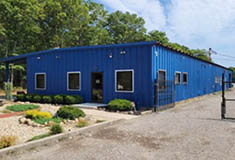Hunt Corp. Question & Answer: Cashing in your chips

Q: We have owned a 50,000 s/f warehouse building that houses our distribution business for many years. What is the best way to unlock the equity in the building in this hot real estate market?
A: Your problem is a common one. I assume that the building is at least close to being fully depreciated. Your building may be worth more than $150 a s/f, or $7.5 million today, but has been depreciated down to close to the land value many years ago! How do you “cash in your chips” and tap the true value of the real estate?
There are three major methods, none of which is the “right” decision. There are advantages and disadvantages to all three.
The first, and probably most obvious choice, is to refinance the building. The major advantage of refinancing is that there is no tax consequence, since loan proceeds are not considered income. The major disadvantage is that only a portion of the property’s value can be tapped. This is governed by the loan to value ratio of the lending institution that is making the loan. As an example, with a loan to value ratio of 70% (fairly common) you could only obtain a loan of $5.25 million based upon a property value of $7.5 million. Another disadvantage is that if the operating company owns the building, the loan will show up on the balance sheet as debt.
Another common way to tap real estate equity is a sale-leaseback. You sell your building to an investor, who in turn, leases the building back to your operating company. One advantage to a sale-leaseback is that you are accessing 100% of the property value. Another advantage is a much stronger balance sheet if the operating company owns the real estate. The depreciated building will be replaced with a healthy influx of cash. In addition, unlike traditional bank debt, sale-leasebacks do not need to be refinanced, with initial terms and options available up to 49 years. The disadvantage of a sale-leaseback is that there will be federal and state taxes to pay on your gain, which is the difference between the sale price, net of expenses, less your adjusted basis in the property (not what you paid for it.)
Finally, you may want to consider selling the building and relocating. One advantage of this method is that you are selling your building to another user, and generally maximizing the sale price. And of course, you are accessing 100% of property value, as in a sale-leaseback. The disadvantages are once again the tax consequences, as well as the cost and inconvenience of moving. However, if you are buying a replacement property, you can defer capital gain taxes through a “1031 exchange” provision with the new property. This may be a good alternative if your business requires more or less space, or more modern quarters. It may also allow the cost of the move to be recovered quickly.
These choices require a full evaluation from your accounting team, particularly if a separate holding company owns your real estate and not the operating company. You should explore all three alternatives to see which is most advantageous for you.
David Hunt, MCR, CCIM, SIOR is the president of Hunt Construction Services, Inc. and Hunt Corporate Services, Inc., Plainview, N.Y.
Suffolk County IDA supports expansion of A&Z Pharmaceuticals


The evolving relationship of environmental consultants and the lending community - by Chuck Merritt
When Environmental Site Assessments (ESA) were first part of commercial real estate risk management, it was the lenders driving this requirement. When a borrower wanted a loan on a property, banks would utilize a list of “Approved Consultants” to order the report on both refinances and purchases.








.gif)
.jpg)